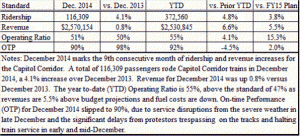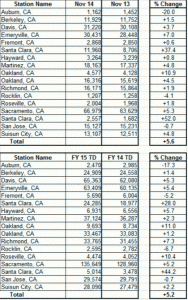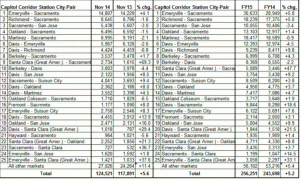From David B. Kutrosky, Managing Director
Capitol Corridor Joint Powers Authority
December 2014 marks the ninth consecutive month of ridership and revenue
increases for the Capitol Corridor. The Capitol Corridor trains carried
116,309 passengers in December 2014, a 4.1% increase compared to December
2013, with revenue increasing by 0.8% compared to December 2013. With year
to-date (YTD) revenue 5.5% above projections, and expenses below budget
(especially fuel prices), the YTD Operating Ratio currently is at 55%
compared to 51% at this time last year.
On-Time Performance (OTP) for December 2014 slipped to the state standard
of 90%, the lowest level of reliability since March 2010. While prior
issues surrounding mechanical delays were resolved and stabilized, there
were extensive delays from third party events [namely trespassing delays
incurred from protestors in early and mid-December and severe weather
impacts in late December] that resulted in a 300% increase in late trains.
Despite these delays, YTD OTP for the Capitol Corridor is 92%, and remains
on top of the leader board in the Amtrak national system.
Using the most recent monthly report provided by Amtrak (November 2014),
the following data is available for train and station segments:
? Ridership for weekday trains was up 6%, with continued growth to and
from the Silicon Valley/San Jose. See the attached tables below for
station city-pairs and station activity.
? Weekend ridership was flat and unchanged.
? The embedded table below shows the decrease in OTP to 93% for the
Capitol Corridor trains in November 2014. This drop in OTP is primarily
attributed to mechanical problems with the train equipment during the
Thanksgiving holiday week. These mechanical issues have been addressed by Amtrak and
CCJPA mechanical staff, and such mechanical delays have been reducing in
frequency and duration in the months of December 2014 and January 2015.
Customer Service Program Upgrades:
? Bicycle Access Program: Using the available rolling stock, CCJPA
has worked with Amtrak to ensure that there are, in most cases, two cars
with extra bicycle capacity on selected trainsets (in the cab car, opposite
the locomotive and in
the car # 2 positions.) This on-board program was instituted in
response to the growing number of passengers who board Capitol Corridor
trains with a bicycle – an increase from 5% mode share four years ago, to
11% today.
To provide additional bike capacity, consistent with the adopted
CCJPA Bicycle Access Plan, in February 2015 the CCJPA will officially kick
off the process to install bicycle eLockers at 13 of the 17 stations
Capitol Corridor serves.
(Exceptions being joint Capitol Corridor/BART stations and
Caltrain stations, which already have bike lockers.) The eLocker
installation will occupy about a one-year effort. Once eLockers gain
momentum, the CCJPA will begin the more
complicated process of implementing a folding bicycle lease
program to further reduce on-train bicycle crowding and/or induce more
convenient and safe Capitol Corridor travel with bicycle access as the
first/last-mile portion of the trip.
· Improvements to CCJPA Train Status Feature on Website: A vendor
is now under contract to implement upgrades to the train status feature on
the CCJPA website and via mobile app. CCJPA staff is coordinating with
Amtrak to set up the data stream. Testing will be underway soon, and it is
anticipated that implementation will happen by March 2015.
· New Passenger Fare Discounts: In February/March 2015, Capitol
Corridor will introduce three fare discounts aimed at increasing off-peak
ridership. The fare discounts are as follows: Take 5 for weekend and
holiday weekend travel, Friends & Family small group discount available every day, and a senior
Midweek discount. Marketing for these discounts will begin in late
February/early March of 2015.
Safety Initiatives
? Security Cameras at Capitol Corridor Stations: With initial
engineering design complete, the installation of camera and surveillance
equipment at the Auburn, Rocklin, Roseville, Suisun, Martinez,
Emeryville, Oakland Jack London, and Fremont stations will begin when funding is secured.
? Platform Safety Upgrades: In early 2014, CCJPA and Amtrak staff
initiated a program of safety access upgrades at selected Capitol
Corridor train stations. The upgrades include, but are not limited to,
replacing broken platform tactile edges, repainting platform tactile edges, restriping yellow safety lines
along the main platform, repainting safety text along platforms, and
installing safety signs. In May 2014, upgrades were completed at the
Davis station, followed by work completed in July 2014 at the Roseville, Suisun, Berkeley, and Fremont
stations. Now these safety upgrades have begun at the Santa Clara/Great
America, Hayward, Oakland-Coliseum, Richmond, Rocklin, and Auburn
stations.
? Positive Train Control Update: The Union Pacific’s plan for PTC
implementation remains the same in that the Los Angeles basin will be
first, with the Northern California area following. Initial reports are
that the implementation of PTC in the LA Basin has been delayed to the third quarter of 2015, putting PTC
installation on the Capitol Corridor route sometime after the fourth
quarter of 2015, or perhaps later. Installation of the PTC equipment on
the state-owned locomotives and cab control cars is complete, with all locomotives and cab cars
equipped. A schedule will be developed with Caltrain and Union Pacific
Railroad to test state-owned PTC-installed Capitol Corridor trains in
Caltrain and Union Pacific territory once the PTC trackside equipment is installed and ready for
testing.
Project Updates
? CCJPA Oakland-San Jose Phase 2 Project: The first task has begun for
this project with surveying and conceptual design for the extensions of
the double track in the segment between the Fremont and Santa
Clara/University stations. The goal of this work will be to increase service frequencies between
Oakland and San Jose.
? Sacramento to Roseville 3rd Track Environmental Review/Preliminary
Engineering: A Notice of Preparation (NOP) as part of the environmental
documentation compliance process with the California Environmental
Quality Act (CEQA) for the project was completed, and the project team is now performing
the environmental analysis for the preparation of the respective CEQA
and NEPA environmental documents. Staff will continue discussions with
the affected resource agencies and the cities of Roseville and Sacramento. Additional
phases of stakeholder engagement, as well as public meetings, are on
schedule for release of the draft EIR/EA in late winter 2015, leading
toward CEQA adoption of the EIR in November 2015 by the CCJPA Board. NEPA approval will be subject to
the Federal Railroad Administration (FRA).
Outlook – Closing
With the completion of the first quarter of FY 2015, the Capitol Corridor
performance is capitalizing on the continued increases in ridership [+4.8%]
and revenues [+6.6%]. The actual results exceed all performance standards
(ridership, system operating ratio and OTP) for the first quarter of FY
2015 (October – December 2014). The CCJPA will be entering into the budget
planning season and will be hosting workshops on the release of the draft
Capitol Corridor Business Plan Update for FY 2015-16 – FY 2016-17 during
the week January 20-23 (see the link:
http://www.capitolcorridor.org/about_ccjpa/business_plan.php . This
business plan presents the operating strategies, marketing plans, and
capital program to meet near-term budget guidelines, implement promotional
initiatives that will retain and grow market share, and lay out a program
of projects and enhancements (both short-range and long-term) that will
expand and enhance the Capitol Corridor as the preferred transport
alternative in Northern California.
The CCJPA has been working with various passenger rail organizations over
the last few months on the 3rd annual California Passenger Rail Summit. In
2015, the events for this Summit will be held in Sacramento with an evening
welcoming reception on Tuesday April 28 and a full-day program on
Wednesday, April 29.


